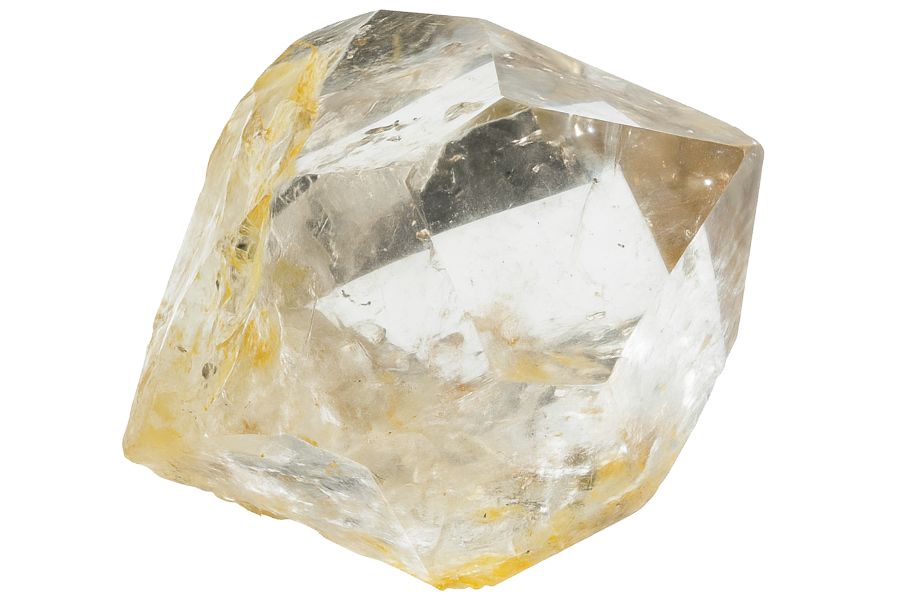If you’re looking for gemstones in New York there are plenty of places to explore. From wooded hillsides to river gravel, the state offers countless spots where you can uncover something that glints in the sunlight.
Each type of terrain offers its own surprises, making every search a little different from the last.
The secret often lies in reading the land and knowing how nature exposes the stones. Areas shaped by water or past mining activity tend to yield the best results. Once you start noticing how certain landscapes reveal hidden minerals, it becomes easier to predict where the next find might be.
We’ll help you get a clearer idea of how and where to look for gemstones in New York. Understanding which locations hold promise and what signs to look for can lead you to a collection full of color and variety.
- The extensive local experience and understanding of our team
- Input from several gem hunting groups and organizations
- The accessibility of the mining locations
- Safety and potential hazards when collecting
- Private and public locations
- A desire to include locations for both experienced gem hunters and those who are just starting out
Overall we’ve been able to put together a great list that anyone can use to locate a lot of beautiful gems.
The Gemstones Found In New York You Can Mine
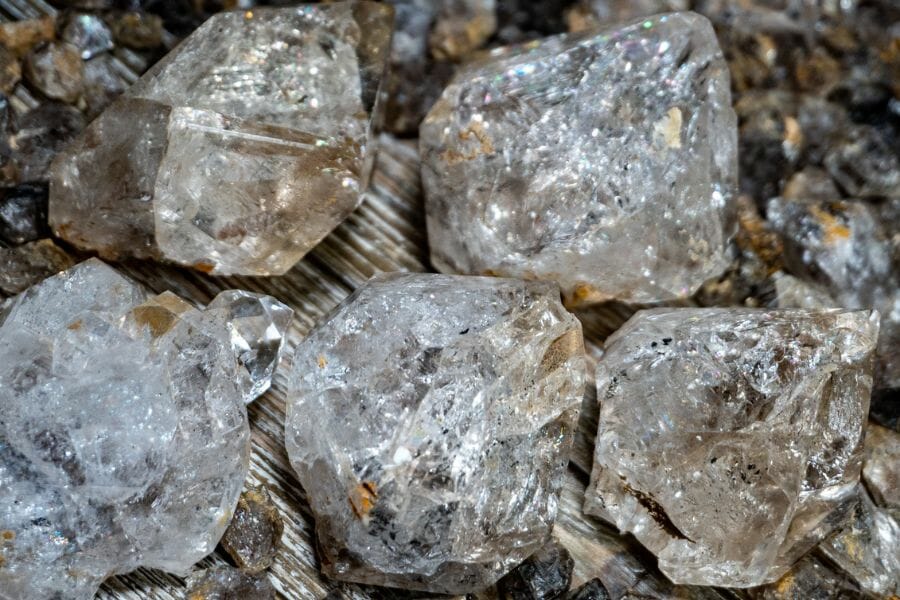
Luckily, some spectacular gemstones may be found in New York. Since each state is unique and not everyone knows where to find this information, we’ve created many guides to assist you in finding gem mines close to you. With the proper knowledge and luck, you can find rare and common gems in this state.
Herkimer Diamond
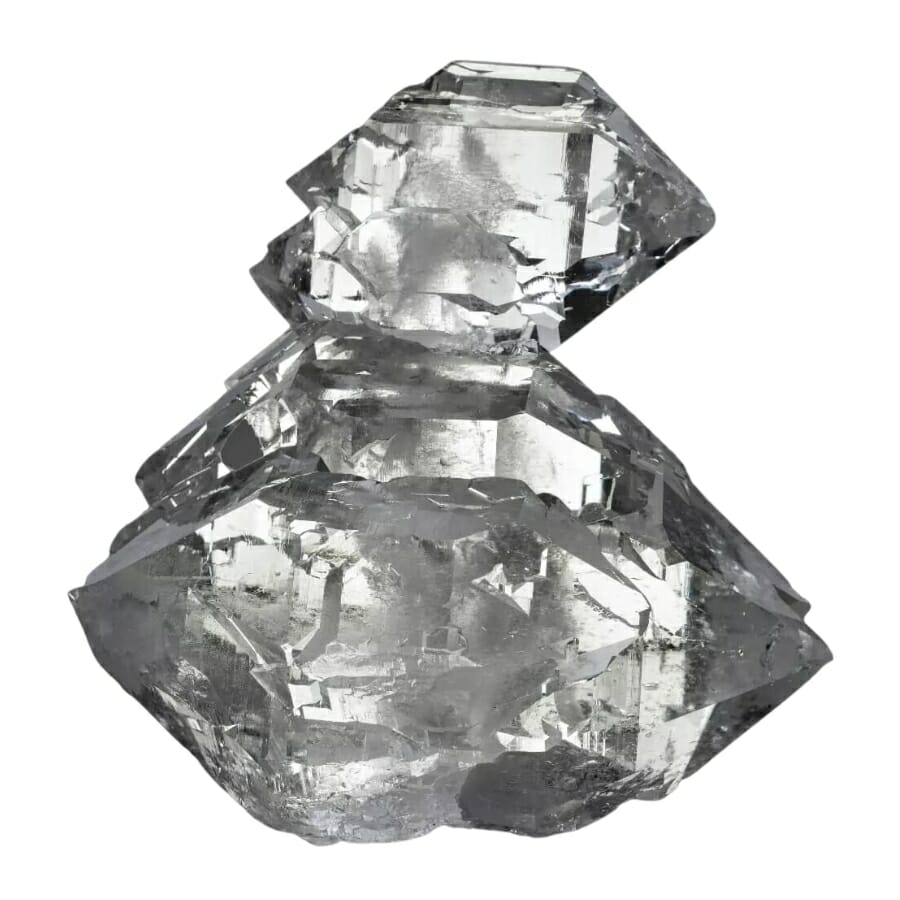
Herkimer Diamond, a sparkling jewel of the mineral world, emerges as a unique and captivating treasure in quartz crystals.
Contrary to its name, Herkimer Diamonds are not diamonds but rather exceptional doubly-terminated quartz crystals found in Herkimer County, New York.
These crystals are renowned for their exceptional clarity, remarkable geometric shapes, and ability to refract light in stunning ways.
The formation of these minerals is a product of ancient geological processes. They are found in dolostone or limestone cavities that formed millions of years ago.
These cavities provided the perfect environment for quartz crystals to grow in doubly-terminated shapes, free from the restraints of the surrounding rock.
“Doubly-terminated” refers to crystals with distinct terminations, or points, at both ends, allowing them to grow freely in open spaces. This unique formation contributes to the Herkimer Diamond’s distinctive appearance.
Their geometric precision makes them ideal for crafting into jewelry, such as necklaces, rings, and earrings. Beyond their beauty, they are treasured by collectors and jewelry enthusiasts for their exceptional clarity and natural beauty.
Where you can find Herkimer Diamond in New York
Herkimer Diamond deposits are abundant in these places:
- Ace of Diamond Mine
- Diamond Acres Mine
- Herkimer Diamond Mine
- Little Nose Hill
- Paradise Falls
Scapolite
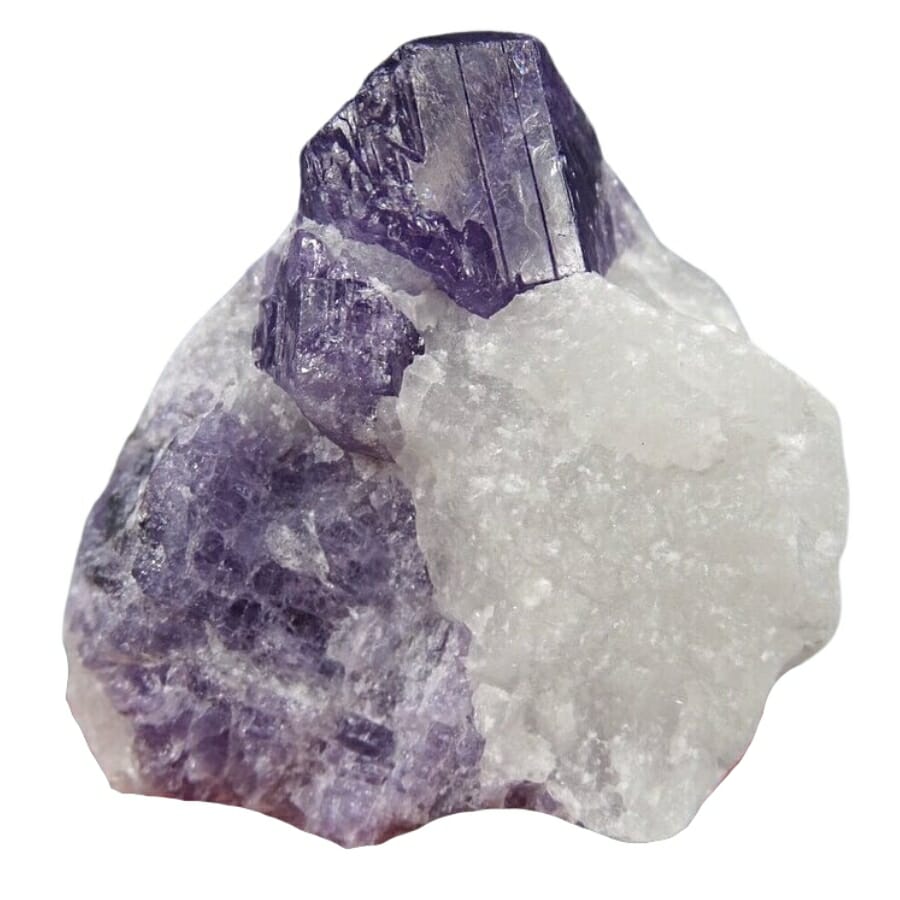
Scapolite, a lesser-known gemstone, is a testament to the Earth’s geological artistry.
Containing silicate minerals with varying compositions, scapolite’s name is derived from the Greek word “skapos,” meaning rod or stem, due to its elongated crystal shapes.
This intriguing mineral forms within metamorphic and igneous rocks, often exhibiting various colors from yellow to purple. In metamorphic environments, it forms as a response to altering pre-existing minerals under elevated temperatures and pressures.
The mineral’s vibrant color variations arise from trace elements within its crystal lattice, producing shades ranging from pale to deep hues. This wide range of colors contributes to scapolite’s appeal among gemstone enthusiasts.
In gemology, scapolite is fashioned into cabochons, beads, and faceted gemstones, often adorning jewelry pieces. Its unique combination of colors and attractive vitreous luster make it an intriguing choice for those seeking a distinctive gemstone.
Its formation, shaped by geological forces, tells a story of Earth’s transformative processes. Meanwhile, its use in decorative arts showcases its ability to bridge the gap between the material and the ethereal.
Where you can find Scapolite in New York
Scapolite can be found in these areas:
- East of Minerva area
- Lake Harris Campground
Bloodstone
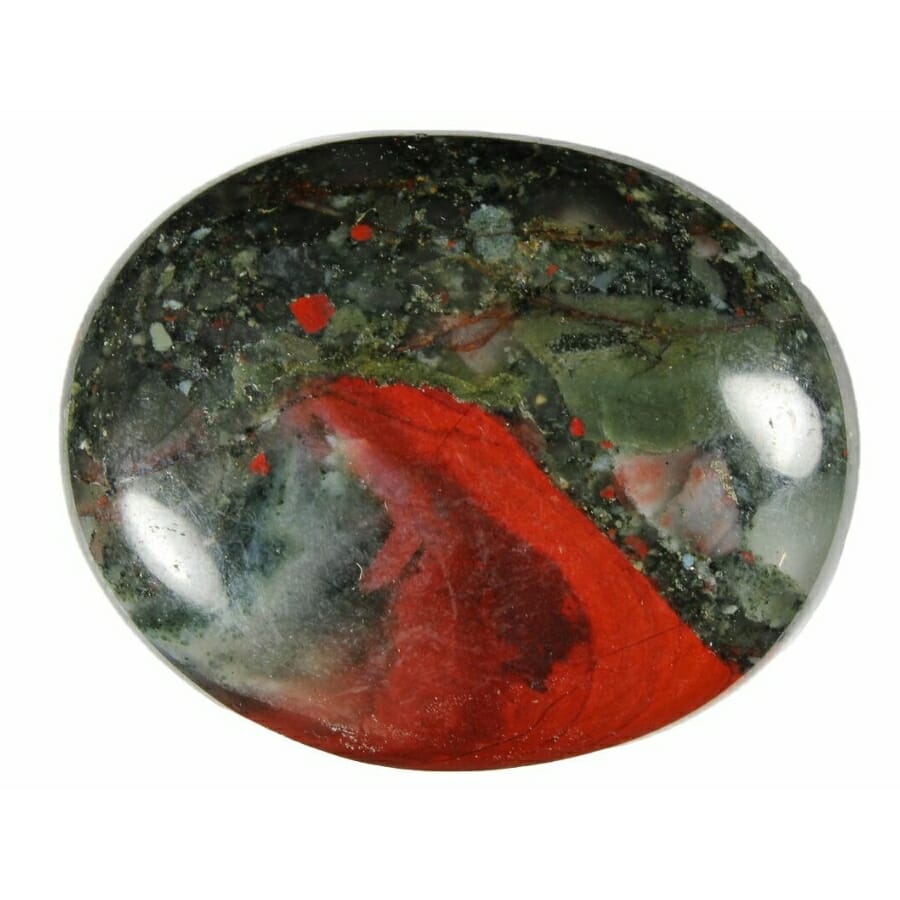
Bloodstone, a captivating gem of ancient legend and deep, rich hues, emerges from the Earth’s embrace through a geological dance that intertwines minerals and history.
Composed mainly of chalcedony with inclusions of red iron oxide, its name evokes its appearance—resembling drops of blood against a verdant background. This intriguing gemstone forms within sedimentary rocks and volcanic environments.
Its formation begins as chalcedony, a type of microcrystalline quartz, interacts with mineral-rich fluids in the Earth’s crust. Over time, these fluids deposit iron oxides and other impurities, giving bloodstone its characteristic red specks or patches against a green backdrop.
Cut into cabochons or carved into intricate designs, this gemstone has adorned jewelry and amulets for millennia. Its durable nature makes it suitable for various types of jewelry, from rings to pendants.
Bloodstone’s stunning colors and unique patterns captivate the eye, while its rich history and symbolic meaning resonate deeply with those seeking to carry a piece of Earth’s mystique.
Where you can find Bloodstone in New York
Bloodstones are often found in these places in New York:
- Craigsville along highway 94
- Hudson River area in Orange County
Apatite
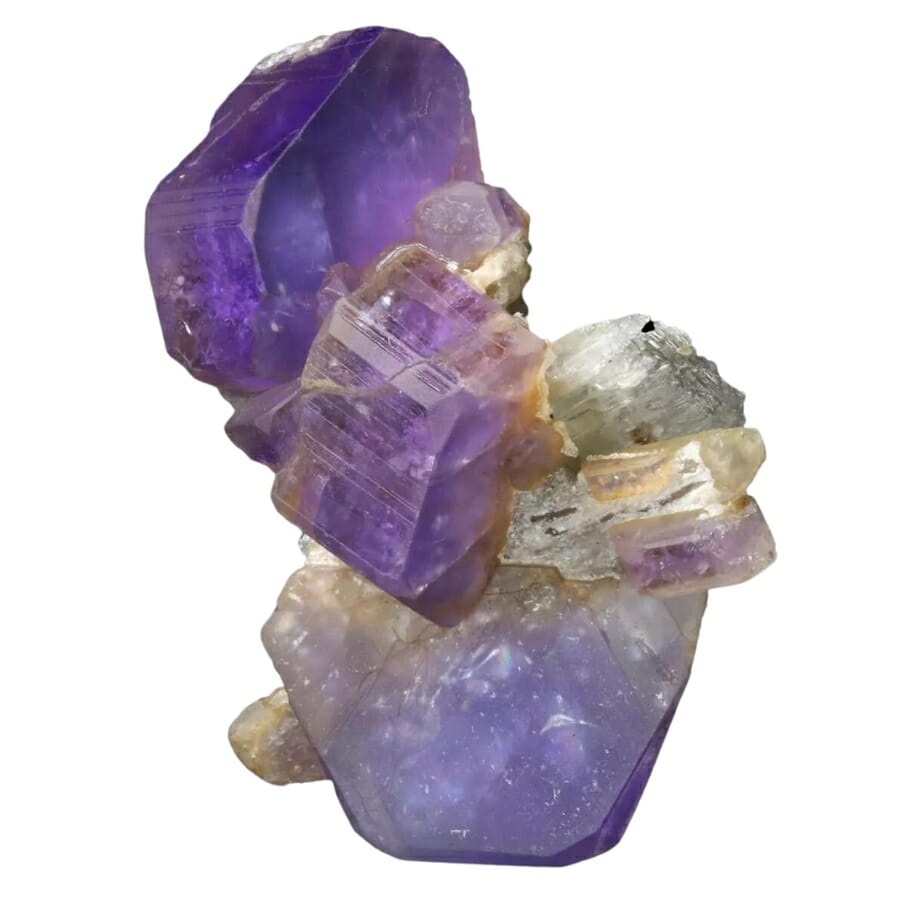
Apatite is a mineral that seems to encapsulate the spectrum of nature’s colors and emerges from the intricate tapestry of geological processes.
Composed mainly of calcium phosphate, apatite’s name originates in the Greek word “apate,” meaning deception, due to its resemblance to other minerals.
This versatile mineral forms within various environments, from igneous to sedimentary, and its mesmerizing hues make it a favorite among collectors and enthusiasts.
Apatite’s formation is as diverse as its appearance, occurring under conditions that vary from the fiery core of volcanoes to the depths of marine sediments. It often develops within the crystallizing magma of igneous rocks and in hydrothermal veins and sedimentary deposits.
Its ability to incorporate trace elements gives rise to its stunning colors, from vivid blues and greens to delicate pinks and purples. This diversity makes apatite a sought-after mineral in gemology and jewelry design.
Apatite plays a crucial role in various industries and scientific applications. In agriculture, apatite’s phosphate content makes it a valuable ingredient in fertilizers, contributing to healthy plant growth and crop yields.
The mineral’s fluorescence under ultraviolet light also serves as a diagnostic tool in geology, helping scientists identify different rock types and geological formations.
Its occurrence in teeth and bones further highlights its significance, as it is a key component in developing skeletal structures in animals, including humans.
Apatite’s charm lies in its multi-faceted nature, embodying the harmony between nature’s craftsmanship and the endeavors of mankind.
Where you can find Apatite in New York
You can find apatite in the following places in the state:
- Crystal Grove Diamond Mine and Campground
- Lyon Mountain
- Oswegatchie River
Corundum
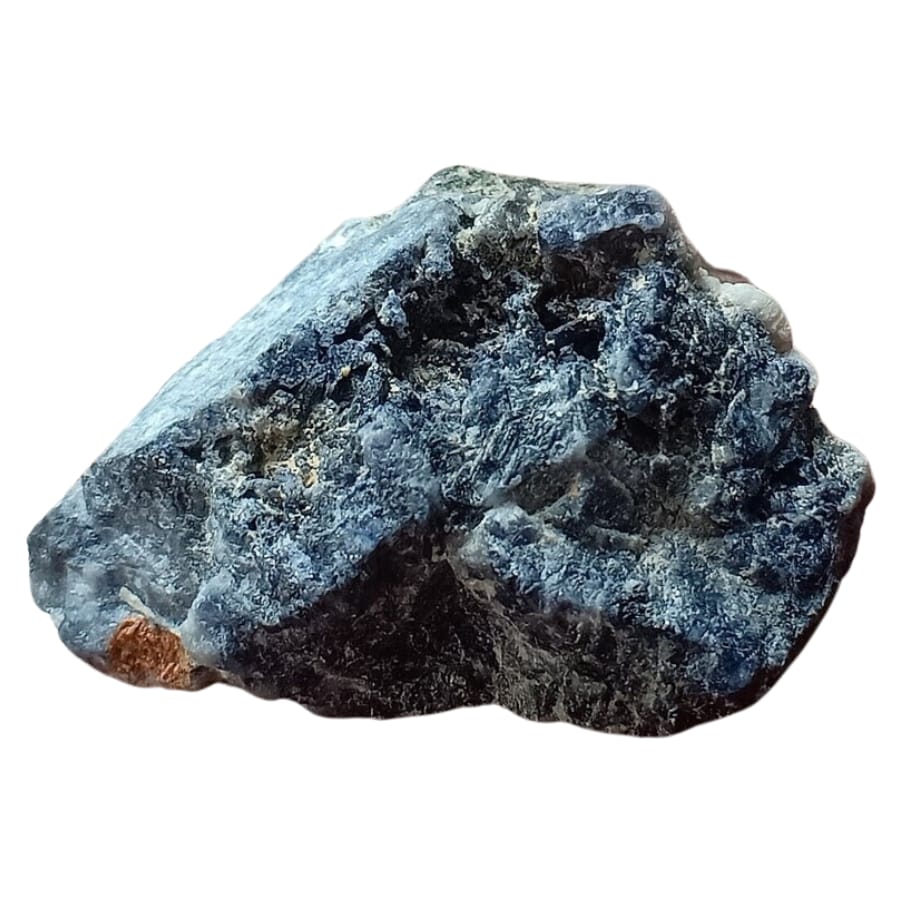
Corundum, a mineral of captivating allure and exceptional hardness, reveals itself in enchanting colors.
Composed mainly of aluminum oxide, this mineral’s formation results from high-temperature geological processes. It originates from igneous and metamorphic environments where extreme heat and pressure sculpt the Earth’s crust.
The fact that corundum crystallizes shows that harsh conditions shape our planet. Corundum crystals form when rocks with a lot of aluminum, like shale and limestone, are heated and pressed very hard.
This process is called metamorphism. This mineral’s beautiful range of colors comes from trace elements like chromium. The hardness and durability of corundum, combined with its remarkable color range, make it an invaluable gemstone in the jewelry world.
Beyond their aesthetic value, corundum’s properties find use in various industrial applications. Its hardness ranks second to diamonds, making it essential in cutting tools, grinding wheels, and abrasives.
Its transparency in the infrared spectrum also renders it valuable in scientific instruments, lasers, and optical components.
The multifaceted significance of corundum lies in its harmonious blend of natural beauty, industrial utility, and cultural reverence. From its role as a symbol of love and wealth to its pivotal place in technological advancement, corundum’s rich legacy has woven a thread connecting ancient traditions to modern innovation.
Where you can find Corundum in New York
Here are the places in the state where corundum is most likely to be found:
- Adirondack Park
- Area limestone outcrops in Amity
Diopside
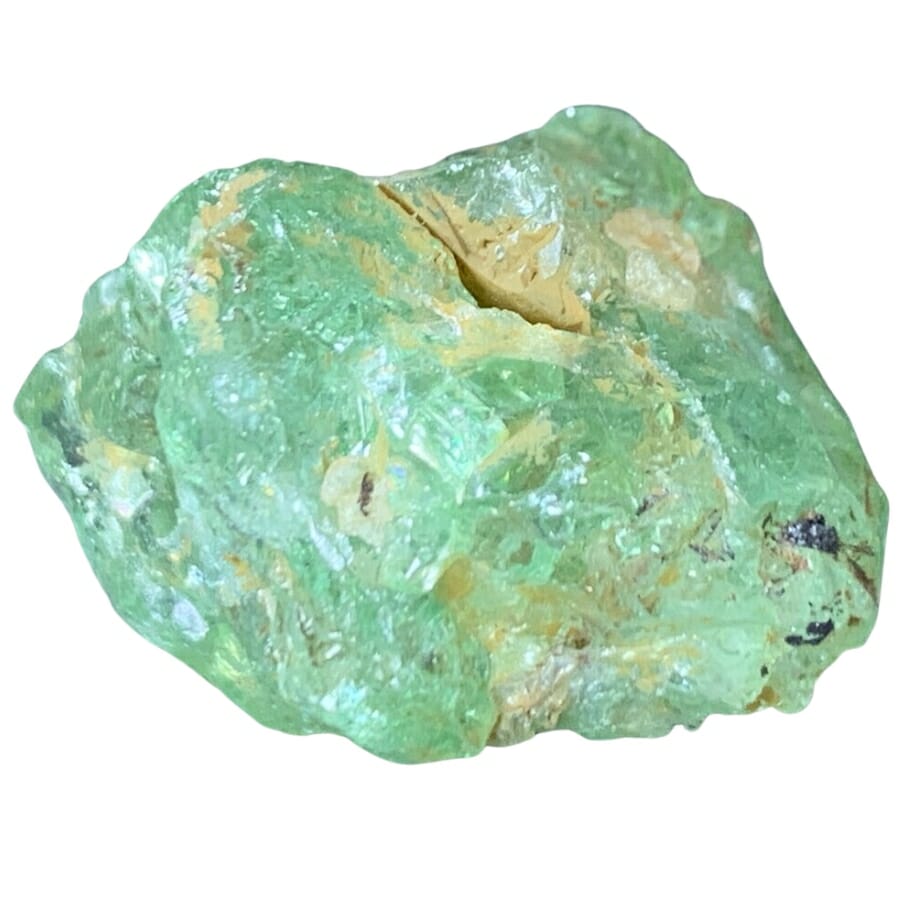
Diopside is a beautiful mineral with bright green colors that comes from the depths of the Earth through complicated geological processes. The name “diopside” comes from the Greek words “dis,” which means “double,” and “opsis,” which means “sight.”
This is because it has a strong property called “pleochroism,” which makes it look different colors when viewed from different angles. This mineral can form in several geological settings but usually comes from igneous and metamorphic rocks.
The formation of diopside is a testament to the transformative powers of heat and pressure deep within the Earth’s crust. As magma cools and crystallizes, it gives rise to the formation of igneous rocks.
In some cases, it develops as a mineral within these rocks, especially in calcium-rich environments. Alternatively, the mineral can arise from the metamorphism of pre-existing rocks, undergoing changes in composition and structure under intense geological pressures.
Although it’s not as widely recognized as some other gemstones, its vibrant green color, and unique optical qualities have earned it a devoted following among collectors and connoisseurs.
Moreover, diopside’s thermal and electrical conductivity has led to its use in manufacturing ceramics, refractories, and electrical insulators.
Diopside’s vibrant appearance and multifaceted significance illustrate the deep connection between Earth’s natural wonders and human appreciation for beauty and knowledge.
Where you can find Diopside in New York
Diopside can be found in places in the state, such as:
- Area quarries of Richville
- Brant Lake
- Lake Harris
Garnet
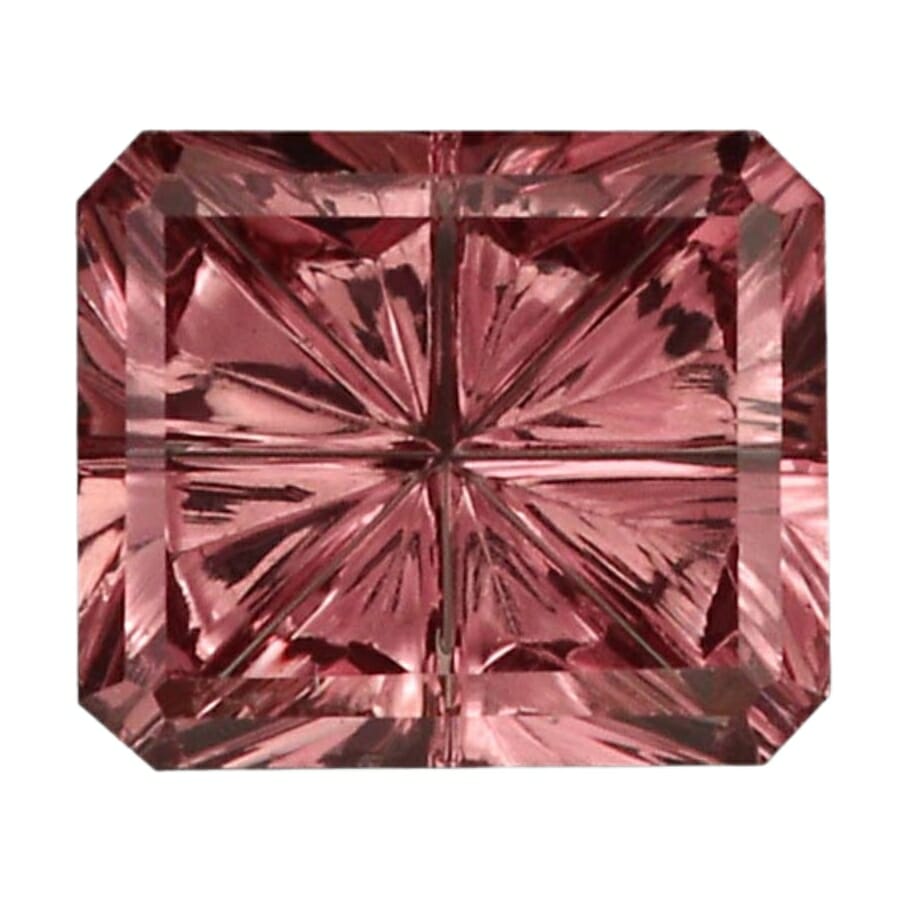
Garnet, a mineral of multifaceted charm and deep, rich hues, emerges from the Earth’s transformational embrace through intricate geological processes.
Comprising a group of silicate minerals with varying chemical compositions, garnets exhibit a remarkable range of colors, from fiery reds to soothing greens.
This mineral forms within diverse geological settings, including metamorphic, igneous, and sedimentary environments. As minerals recrystallize during the metamorphic transformation of rocks, it emerges as a product of these geological changes.
The unique colors within garnets result from the presence of different elements, such as iron, manganese, and aluminum, which lend their distinctive hues to this mineral group.
Garnets often grow in metamorphic rocks like schist or gneiss, where the heat and pressure create the ideal conditions for their crystallization.
Beyond its aesthetic, garnet’s versatility and durability have made it invaluable across various industries. Its hardness makes it an ideal abrasive material for tools, sandpaper, and waterjet cutting.
Garnet sand is also used in water filtration systems and as a natural abrasive in cleaning. In addition to its industrial applications, garnet’s captivating appearance has made it a sought-after gemstone for centuries, adorning jewelry and decorative items.
Whether embraced as a gemstone or harnessed for its practical uses, garnet embodies the intricate harmony between the Earth’s geological processes and the complex desires of the human heart and mind.
If you’re curious how much garnet is worth, we’ve written an article detailing your needed information.
Where you can find Garnet in New York
Garnet can be found all over New York, especially in the places below:
- Ace of Diamond Mine and Campground
- Adirondack Park
- Area mines of Mt. Bigelow in Essex County
- Hooper Garnet Mine
- Old mines of Oven Mountain
Labradorite
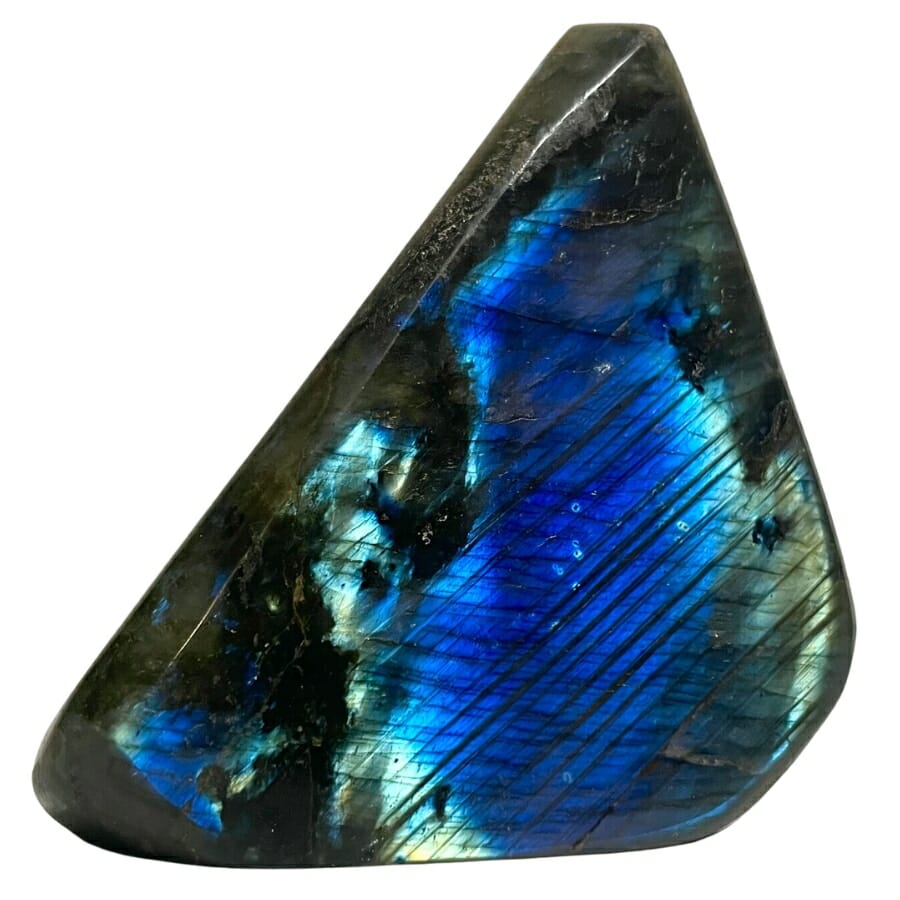
Labradorite is a mineral that seems to hold the magic of the Northern Lights in its shimmering depths. It’s a great example of how well the Earth’s rocks were put together.
It’s a beautiful gemstone with a structure made of silicates rich in feldspar and iridescent layers. Its play of colors reminds me of a rainbow dancing across the night sky.
This mineral forms in igneous rocks, especially where there is a lot of volcanic activity or magma flows into the ground.
The formation of labradorite unfolds as molten magma cools and solidifies, creating the perfect environment for the growth of distinct crystals. As this process occurs, labradorite’s unique iridescence, known as labradorescence, arises due to the interference and scattering of light across its layers.
Its remarkable optical effect results from the mineral’s composition and the intricate interplay of its crystals. The mineral’s hardness and durability make it suitable for carvings, sculptures, and decorative objects.
Its ability to evoke wonder and captivate the imagination and its geological rarity make labradorite a gemstone cherished by people worldwide.
Where you can find Labradorite in New York
Here are a list of places where you can find labradorite:
- Candice Lake
- Cascade Lakes
- Gravel beds and bars of Opalescent River
- Honeoye Lake
Sapphire
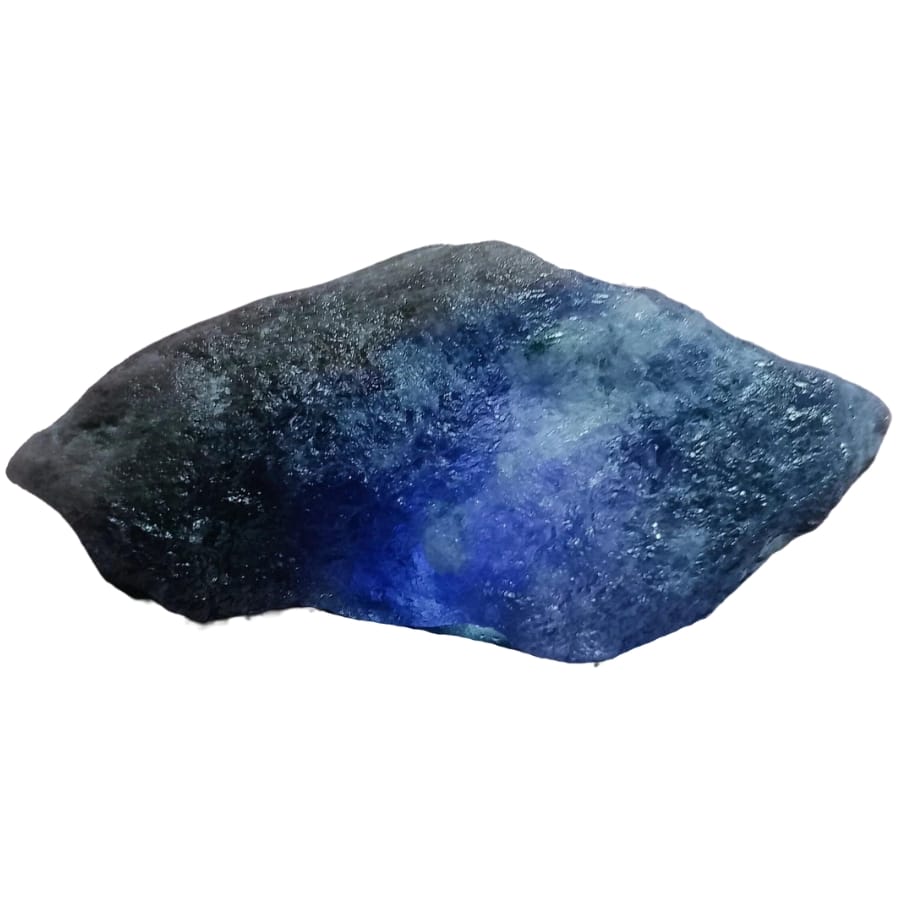
Sapphire is a mineral with beautiful, deep colors that draw people in. It’s a sign of wisdom, loyalty, and nobility. It’s mostly made of corundum, which is an aluminum oxide crystal.
People have been interested in sapphire’s distinctive blue color for thousands of years. Deep inside the Earth’s crust, heat, pressure, and trace elements work together to make this valuable gemstone.
The formation of sapphire results from the same geological forces that shape rubies, with the primary difference being the presence of different trace elements. These elements, such as iron and titanium, lend sapphire its range of colors, including the sought-after blue that has become synonymous with this gemstone.
The process begins within igneous and metamorphic environments, where corundum crystals form under immense heat and pressure. Incorporating these trace elements imbues the corundum crystals with their distinctive hues.
Its use in electronics, optics, and scientific instruments underscores its contribution to cutting-edge technology and innovation.
Meanwhile, its role in advancing technology and enhancing the functionality of various industries showcases its broader impact on modern society.
Sapphire is more than just a mineral; it reflects the Earth’s geological wonders and is a testament to humanity’s appreciation for both the aesthetic and the practical.
We’ve put together an article about sapphire’s value and current price for everyone who wants to learn more about it.
Where you can find Sapphire in New York
You can find sapphire deposits at the Ace of Diamond Mine and Campground.
Sunstone
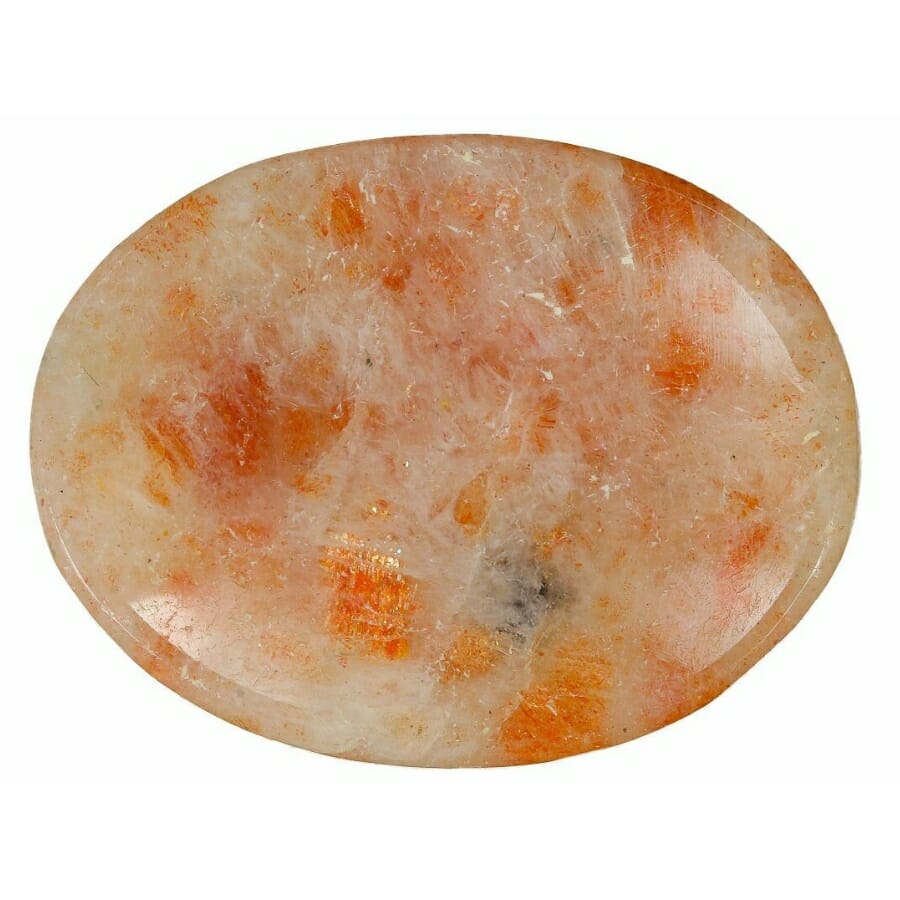
Sunstone, a gem of otherworldly charm and iridescent splendor, emerges from the heart of the Earth through a geological dance that captivates the eye. Made mainly of feldspar with inclusions of minerals like hematite or copper, sunstone’s name captures its fiery appearance, reminiscent of the sun’s warm glow.
This captivating mineral forms within igneous rocks, often originating from volcanic processes. The formation of it begins as magma slowly cools and solidifies deep within the Earth’s crust, creating an environment conducive to the growth of crystals.
As the magma hardens, layers of feldspar and other minerals interlock, trapping tiny platelets of hematite or copper. These platelets are responsible for the mesmerizing play of colors that sunstone is famous for.
As light interacts with these inclusions, it scatters and refracts, creating a stunning dance of vibrant oranges, reds, and golds. Its unique play of colors mirrors nature’s vibrant beauty, and its jewelry use connects the wearer to the Earth’s artistry.
Cut into faceted gemstones or polished into cabochons, its dazzling play of colors makes it a favorite among designers and collectors. While it’s not as widely known as some other gemstones, its radiant appearance and connection to the natural world have garnered it a devoted following.
Whether admired for its dazzling iridescence or appreciated for its symbolic resonance, sunstone is a testament to the harmonious blend of science, art, and the natural world.
Where you can find Sunstone in New York
There is a lot of sunstone in the following places in New York:
- Area outcrops and gravels Crown Point
- Fisher Hill Mine
- Owl’s Head Mountain Trail
Celestite
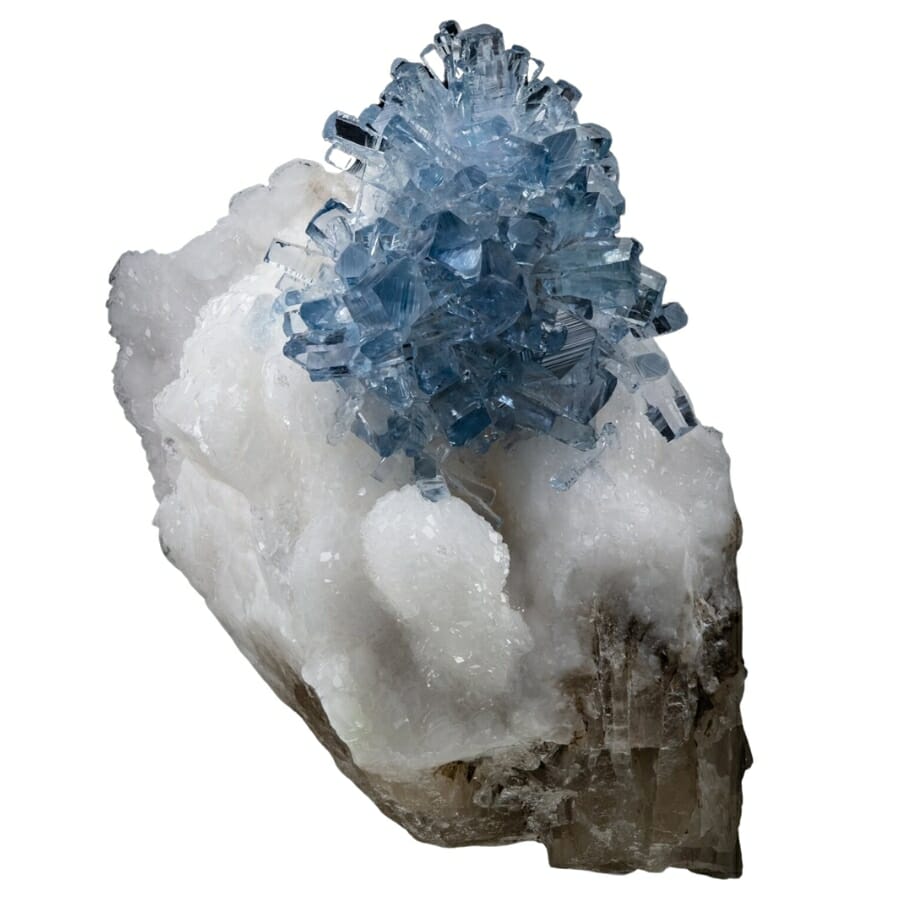
Celestite, a mineral of celestial beauty and delicate hues, emerges as a reflection of the skies within the Earth’s geological canvas.
Composed mainly of strontium sulfate, its name is derived from the Latin word “caelestis,” meaning heavenly or celestial, due to its blue shades reminiscent of the sky.
In ancient oceanic environments, the gradual accumulation of strontium-rich minerals and other chemical reactions led to the creation of its deposits.
As these sediments compacted and solidified over time, they formed rocks containing pockets or geodes of crystalline celestite. The unique blue color that defines it arises from the presence of strontium in its crystal lattice.
The mineral’s gentle blue tones have led to its use as a pigment in the ceramics, paint, and glass industries. Its natural crystal formations have also made it a favored collectible among mineral enthusiasts and collectors.
The charm of celestite lies in its ability to evoke a sense of wonder and connection to the cosmos. Its formation within the Earth’s history echoes the profound interactions between water, minerals, and geological forces.
Where you can find Celestite in New York
Celestite is abundant in the following areas in New York:
- Area quarries of Chittenango Falls
- Area exposures of the Roundout Waterline
Fluorite
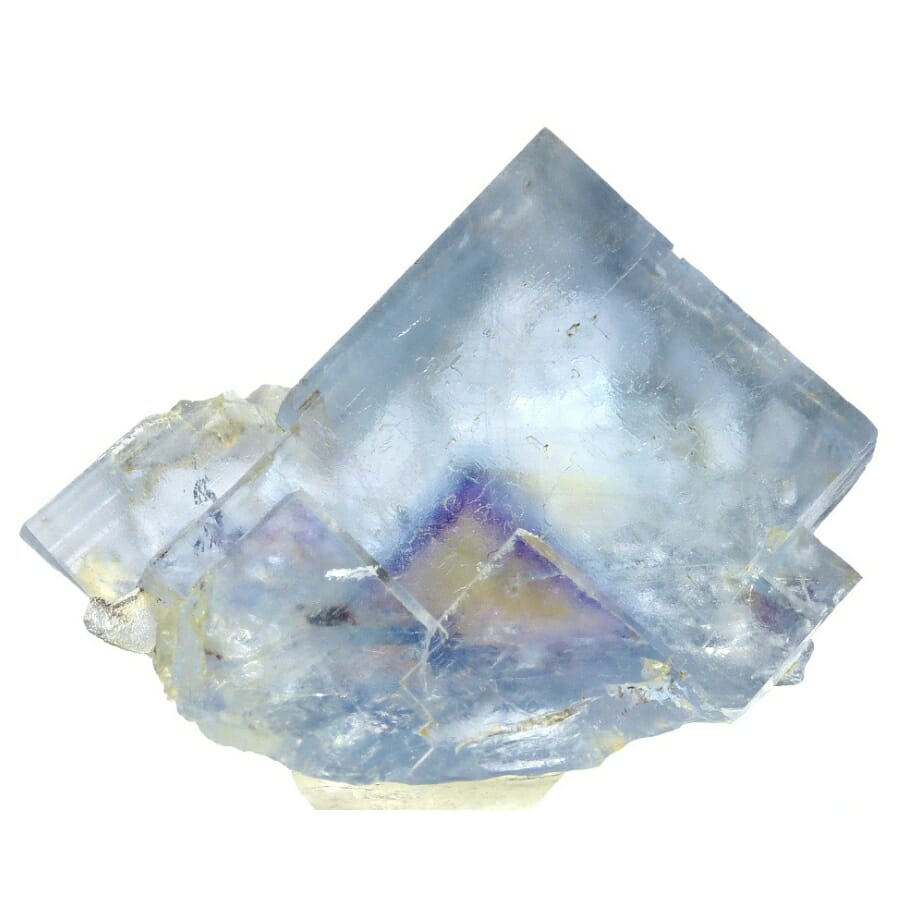
Fluorite’s appealing range of colors, often exhibiting intricate patterns and vibrant hues, has made it a favorite among mineral enthusiasts and collectors. This mineral forms within various geological environments, from hydrothermal veins to sedimentary deposits.
The formation of the mineral is a product of the interaction between hydrothermal fluids and existing rocks. As mineral-rich solutions circulate through the Earth’s crust, they dissolve and carry various elements, including calcium and fluorine.
When these fluids encounter spaces within rocks, they cool and deposit the dissolved minerals, leading to the growth of fluorite crystals.
The broad spectrum of colors seen in fluorite results from different trace elements present during crystal growth, and the level of light absorption and dispersion varies across other specimens.
Its distinctive property of fluorescence under ultraviolet light has led to its use in making fluorescent lights and scientific research and spectroscopy. Additionally, fluorite’s transparency in the infrared range makes it valuable in manufacturing optical components like lenses and prisms.
Its role in the steel and aluminum industries as a flux, aiding in removing impurities during smelting, further underlines its industrial significance.
Its remarkable appearance, diversity, and practical properties make fluorite a valuable mineral that transcends the boundaries between science and art, showcasing the intricate connection between the Earth’s creations and human imagination.
Where you can find Fluorite in New York
You can find fluorite deposits in these places in the state:
- Muscalonge Lake
- Oswegatchie River
- Palmer Hiss Mine
- Rylestone Quarry
Galena
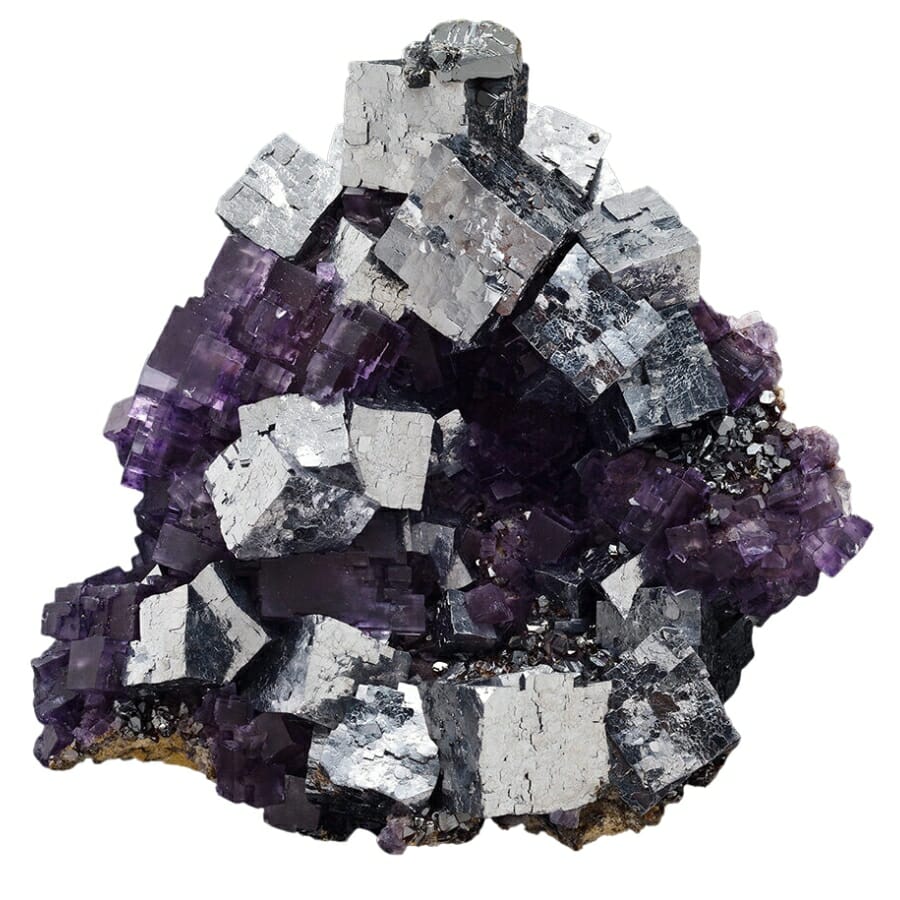
Galena, a mineral with a rich history and striking metallic luster, emerges from Earth’s depths through complex geological processes.
Composed mainly of lead sulfide, it has been a valuable resource for centuries, with its name derived from the Latin word “galena,” meaning lead ore. This mineral forms primarily in hydrothermal veins and sedimentary environments, often crystallizing in cubic or octahedral shapes.
The formation of this mineral is intertwined with the hydrothermal circulation of mineral-rich fluids within the Earth’s crust. As these fluids move through fractures and cavities in rocks, they interact with various elements, including lead and sulfur, and precipitate crystals.
Galena’s association with lead has made it a vital metal source for numerous industrial applications. Its value has been recognized throughout history for its role in producing lead, a metal of significant importance for various industrial processes.
It was used extensively to produce construction lead, batteries, and ammunition. In modern times, lead’s toxicity has led to decreased use, but galena remains a silver source, often found as a byproduct within the mineral.
Galena tells a story of the Earth’s geological evolution, while its varied uses, from industrial to ornamental, reflect its ability to contribute to both practicality and aesthetic appreciation.
Where you can find Galena in New York
A lot of areas contain galena in New York, including:
- Balmat-Edwards Zinc Deposit
- Dutchess County area mines
- Phoenix Mine
Hematite
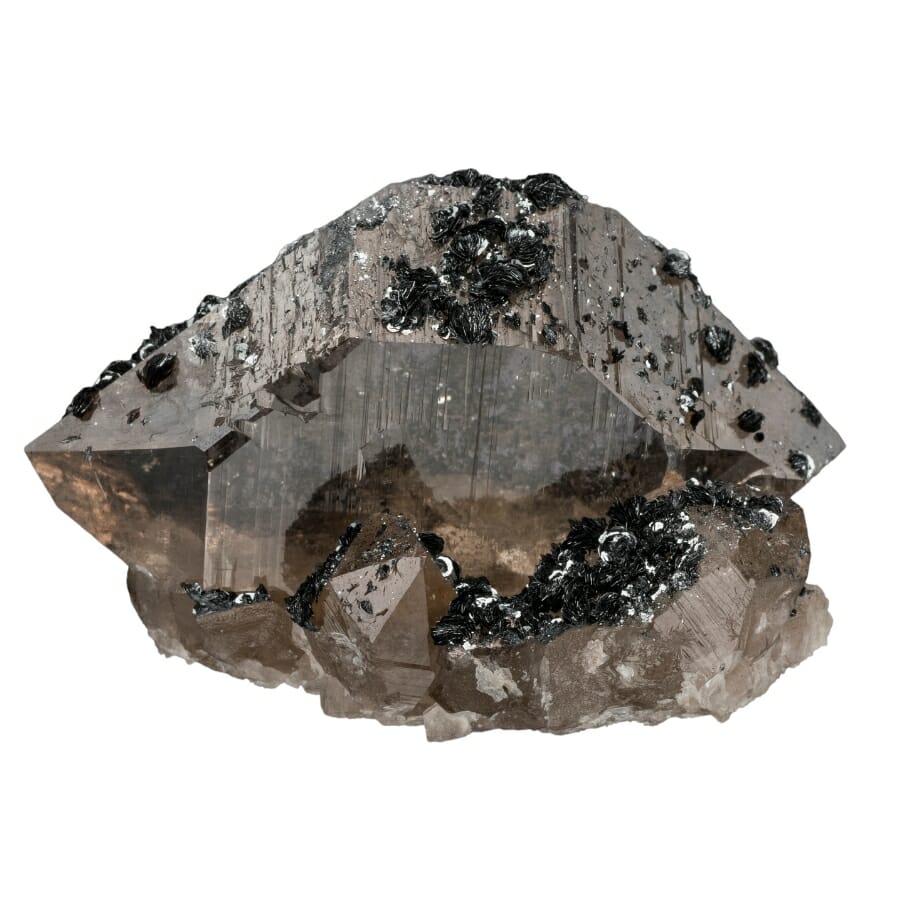
Hematite derives its name from the Greek word “haima,” meaning blood, due to its striking red color when powdered. This mineral forms in various environments, from hydrothermal veins to sedimentary deposits, and its presence on Mars has even intrigued planetary scientists.
In hydrothermal environments, hot mineral-rich waters circulate through cracks and cavities within rocks, depositing iron oxide as they cool. This process leads to the formation of hematite crystals, often exhibiting a metallic luster.
In sedimentary environments, hematite can develop through the accumulation of iron-rich sediments over time. Additionally, hematite’s presence on Mars has sparked interest in understanding its formation in extraterrestrial contexts, potentially shedding light on its geological history.
Its red pigment has been used in paints, dyes, and cosmetics, contributing to cultural and artistic expressions. Hematite’s magnetic properties have also made it valuable in scientific research and industrial applications, including as a component in magnetic storage devices and water purification.
The value of hematite lies in its multifaceted nature, embodying the practical and aesthetic aspects of the Earth’s geological treasures.
Where you can find Hematite in New York
Hematite is abundant in these places in New York:
- Area stream beds and sedimentary exposures of Fowler
- Lyon Mountain
Our Favorite Places For Gem Mining in New York
These are the places in the state we’ve found to be the best for mining gems. To learn more about how to mine gems, you must go to these well-known places. We also gave ideas for places where kids can learn about gem hunting and enjoy the thrill of it.
Always Confirm Access and Collection Rules!
Before heading out to any of the locations on our list you need to confirm access requirements and collection rules for both public and private locations directly with the location. We haven’t personally verified every location and the access requirements and collection rules often change without notice.
Many of the locations we mention will not allow collecting but are still great places for those who love to find beautiful rocks and minerals in the wild without keeping them. We also can’t guarantee you will find anything in these locations since they are constantly changing.
Always get updated information directly from the source ahead of time to ensure responsible rockhounding. If you want even more current options it’s always a good idea to contact local rock and mineral clubs and groups
Lake Harris Campground
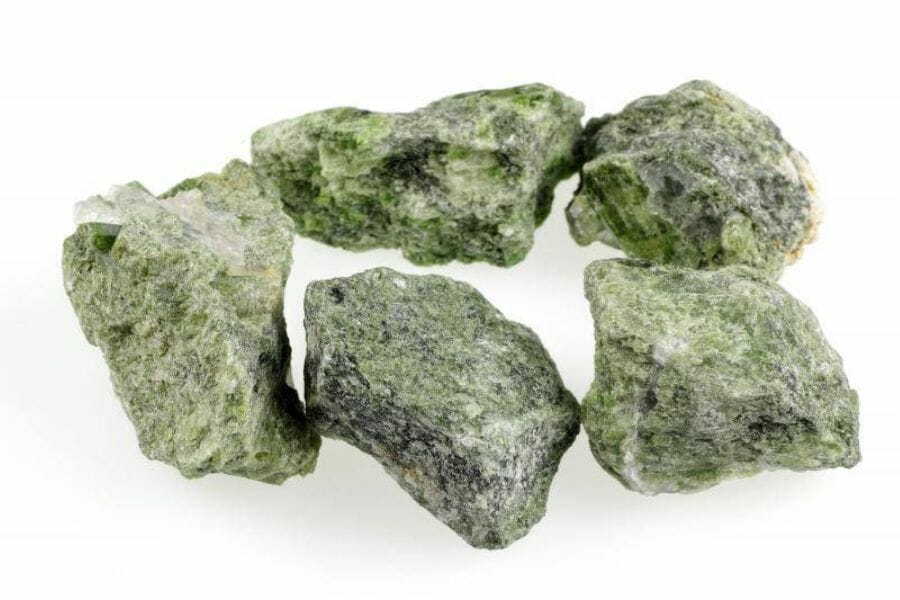
Newcomb, NY 12852, United States
Lake Harris Campground offers a unique experience for campers and adventure seekers alike. The campground is home to a variety of activities, including gem hunting. Gem hunters can search for precious stones in the lake’s gravel beds. You can also rent equipment from the campground store and look for gemstones.
The Types Of Gemstones Found At Lake Harris Campground
Here, gem hunters can locate various gemstones, including:
- Albite
- Apatite
- Diopside
- Pyrite
- Smoky Quartz
- Scapolite
- Tourmaline
- Tremolite
The Best Time To Visit Lake Harris Campground
The best time to visit Lake Harris Campground to dig for gems is during the summer months of June, July, and August. These months provide the most favorable weather conditions for mining gemstones and other outdoor activities.
If you want REAL results finding incredible rocks and minerals you need one of these 👇👇👇
Finding the coolest rocks in isn’t luck, it's knowing what to look for. Thousands of your fellow rock hunters are already carrying Rock Chasing field guides. Maybe it's time you joined the community.
Lightweight, mud-proof, and packed with clear photos, it’s become the go-to tool for anyone interested discovering what’s hidden under our red dirt and what they've already found.
Join them, and make your next rockhounding trip actually pay off.
What makes it different:
- 📍 Find and identify 140 incredible crystals, rocks, gemstones, minerals, and geodes across the USA
- 🚙 Field-tested across America's rivers, ranchlands, mountains, and roadcuts
- 📘 Heavy duty laminated pages resist dust, sweat, and water
- 🧠 Zero fluff — just clear visuals and straight-to-the-point info
- ⭐ Rated 4.8★ by real collectors who actually use it in the field
Hooper Garnet Mine
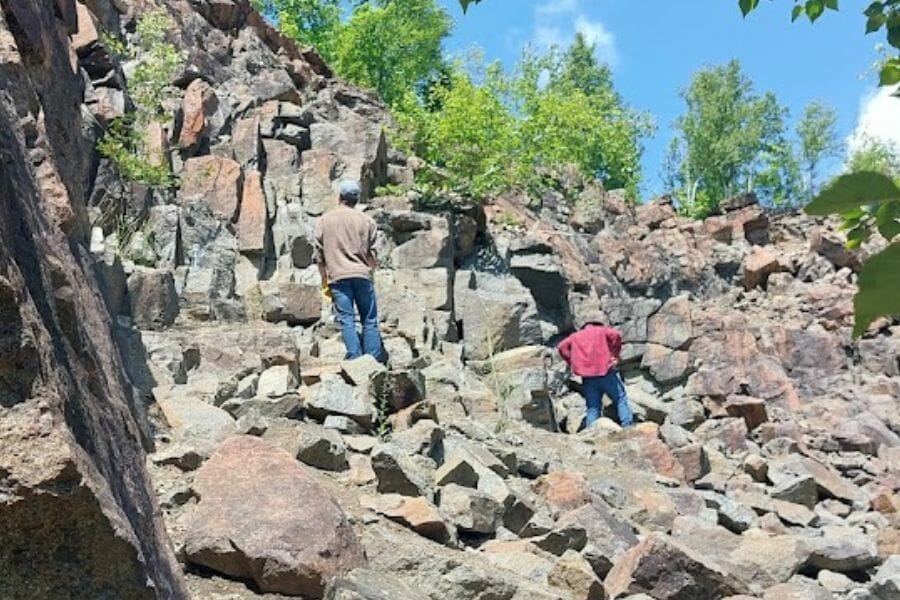
North Creek, NY 12853, United States
Hooper Garnet Mine is located in the Adirondack Mountains and is one of the country’s oldest and most famous garnet mines. The mine has been producing high-quality garnets since 1878.
Here we experienced Hooper Garnet Mine’s tours of the mine and various educational programs about geology, mining history, and garnet formation. We also had the chance to purchase garnets from the gift shop onsite. You may also visit this article for more areas you can find crystals in New York.
The Types Of Gemstones Found At Hooper Garnet Mine
This mine has produced numerous gemstones over the years, some of which include:
- Albite
- Almandine Garnet
- Rutile
The Best Time To Visit Hooper Garnet Mine
The mine is open year-round, but gem hunters can enjoy a more comfortable experience while exploring the mine during summer.
Adirondack Park
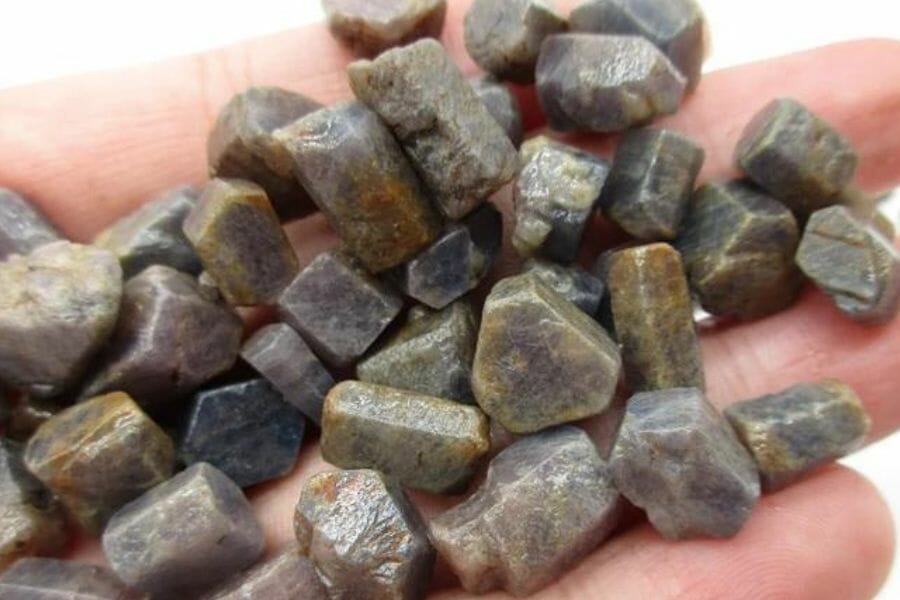
New York, NY, United States
Adirondack Park is a vast and beautiful natural area located in the northeastern part of the Empire State. It encompasses over 6 million acres of land and water, making it the largest publicly protected area in the country. The park is home to various ecosystems, including forests, mountains, lakes, rivers, wetlands, and more.
Its unique combination of human culture and natural beauty makes it a popular destination for outdoor recreation, such as gemstone hunting. Adirondack Park is home to many gems, minerals, and fossils, and gem miners can search for these treasures in the streams and rivers of the park.
The Types Of Gemstones Found At Adirondack Park
The gemstones frequently encountered here are:
- Corundum
- Garnet
- Herkimer Diamond
The Best Time To Visit Adirondack Park
The weather is usually mild and sunny from May to October, making it an ideal time for looking for gems. The park also offers a variety of trails and scenic views that are best enjoyed during the warmer months.
Ace Of Diamond Mine And Campground – Great for kids
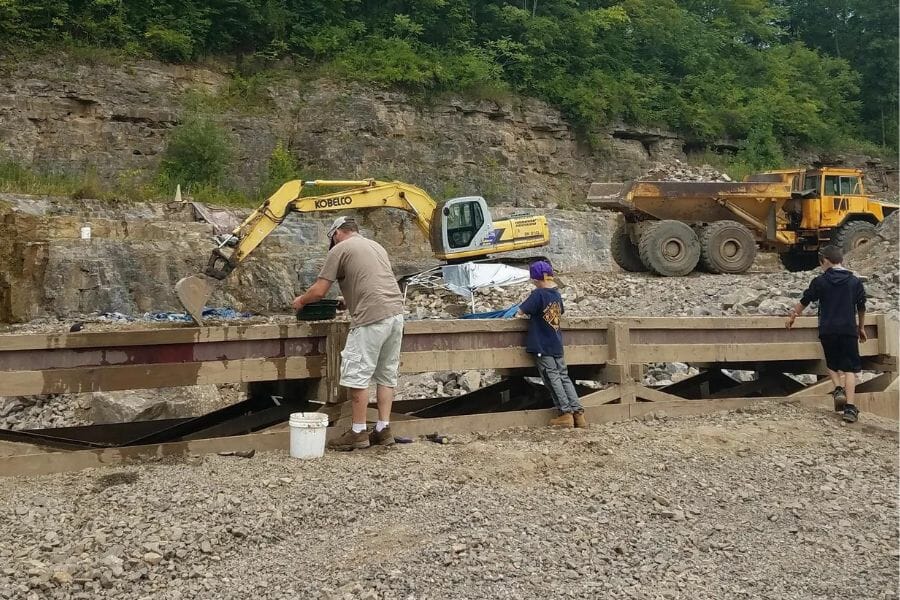
84 Herkimer Street, Middleville, NY 13406, United States
Ace of Diamond Mine and Campground is a gem hunting and camping destination located in the Catskill Mountains, where you can explore the mine for various gemstones. This campground offers a wide range of activities for all ages. You can participate in various activities such as gold panning or prospecting for gems.
The Types Of Gemstones Found At Ace Of Diamond Mine And Campground
This area contains many gems and minerals of excellent quality. But the most typical gemstones found here are:
- Amethyst
- Aquamarine
- Citrine
- Emerald
- Garnet
- Herkimer Diamond
- Opal
- Peridot
- Quartz
- Ruby
- Sapphire
- Topaz
The Best Time To Visit Ace Of Diamond Mine And Campground
The peak season for hunting gems is usually May through August, when temperatures are warm enough to make outdoor activities enjoyable. During these months, gem miners can expect to find various gems.
Crystal Grove Diamond Mine and Campground – Great for kids
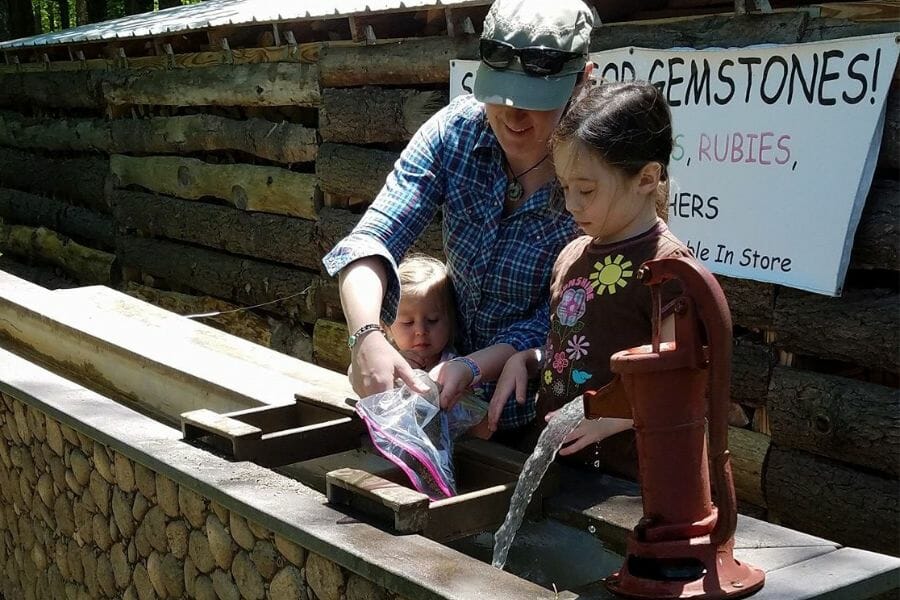
Crystal Grove, 161 Co Rd 114 St. Johnsville, NY 13452, United States
Crystal Grove Diamond Mine and Campground is an outdoor adventure park and diamond mine where you can pan for real diamonds and other precious gems! The mine also features a campground with RV sites, camping cabins, tent sites, and more. Gem miners can explore the mine’s trails or take a guided tour.
This was an unforgettable experience that allowed us to not just only search for gems but also camp out and do different fun outdoor activities.
The Types Of Gemstones Found At Crystal Grove Diamond Mine And Campground
The following gemstones are most often discovered here:
- Agate
- Amethyst
- Apatite
- Calcite
- Garnet
- Herkimer Diamond
- Quartz
- Tourmaline
The Best Time To Visit Crystal Grove Diamond Mine And Campground
The best time to visit the Crystal Grove Diamond Mine and Campground is in July and August when the weather is warm and sunny. The campground is open from April through October, but summer is the best time for camping, exploring, and mining gems.
Other Great Options For Real Gem Mining in New York
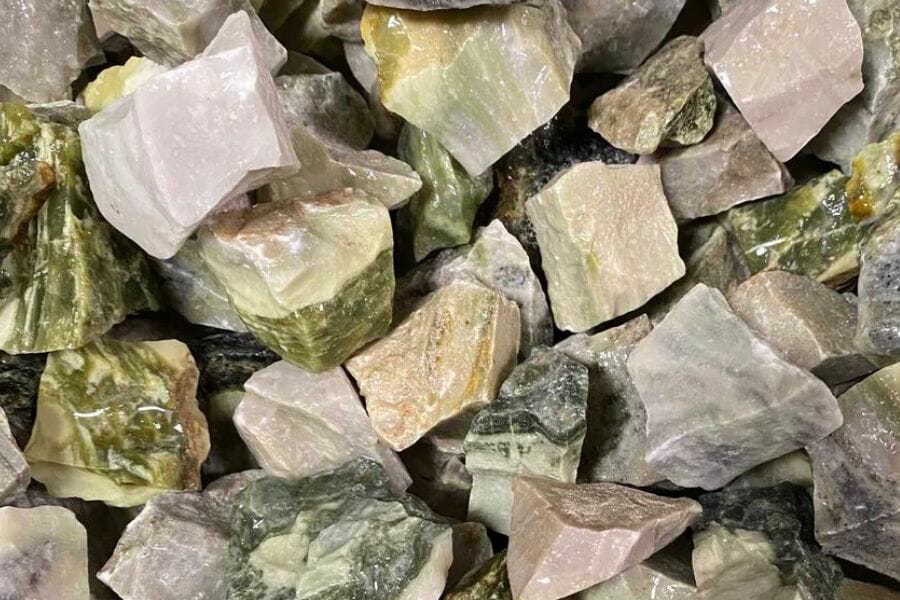
There are plenty more amazing places in New York to look for gems. In addition to our top selections from the list above, here are a few more wonderful places you should visit if you want to go real gem mining in this state.
- Arnold Hill Mine – Jasper, Quartz
- Brant Lake – Apatite, Calcite, Diopside, Pyrite, Rutile, Tourmaline
- Buttermilk Falls State Park – Serpentine
- Candice Lake – Labradorite, Pyrite
- Cascade Lakes – Labradorite
- Clay Pit Pond State Park – Serpentine
- Crehore Mine – Garnet
- Diamond Acres Mine – Herkimer Diamond, Quartz
- Eighteen Mile Creek – Pyrite
- High Rock Park – Serpentine
- Humphrey Mountain – Almandine Garnet
- Lyon Mountain – Albite, Apatite, Calcite, Epidote, Hematite, Orthoclase, Perthite, Pyrite, Quartz, Zircon
- Opalescent River -Labradorite
- Oswegatchie River – Apatite, Calcite, Quartz
- Owl’s Head Mountain Trail – Feldspar, Sunstone
- Palmer Hill Mine – Fluorite, Quartz
- Pine Pond – Pyrite
- Tilly Foster Iron Mine – Brucite, Clinochlore, Titanite
If you’ve ever struggled with identifying gems, our guides are the solution you’ve been looking for:
The Top Public Gem Mining Locations in New York
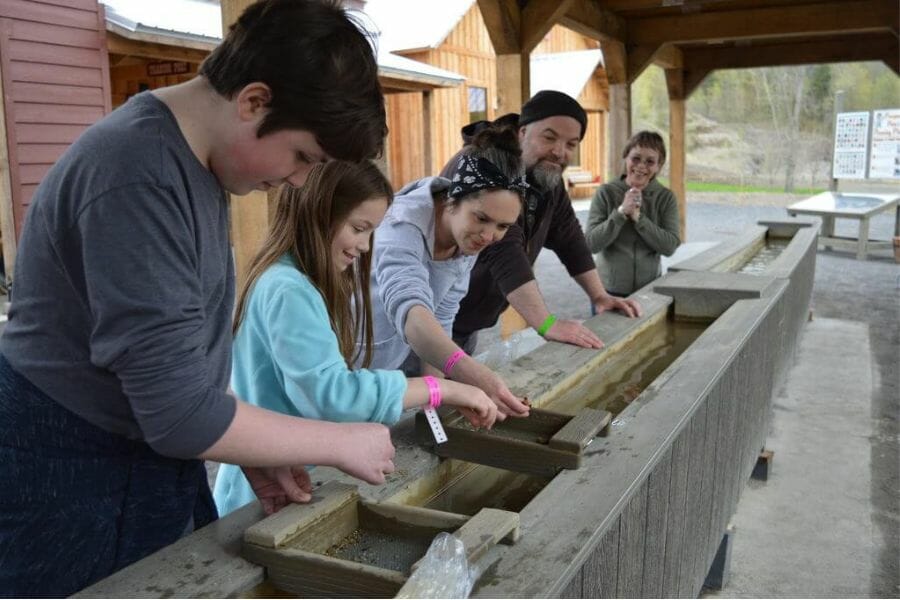
For families that want to expose their children to the hobby of gemstone mining, we also have more great recommendations for public gem mining.
- Gore Mountain Gem and Mineral Shop – 1126 Barton Mines Rd, North Creek, NY 12853, United States
- Herkimer Diamond Mine – 4601 NY-28, Herkimer, NY 13350, United States
- Paradise Falls – Middleville, NY 13416, United States
New York Gem Mining Laws And Regulations
New York State has a variety of regulations in place to protect the environment and ensure the safety of recreational gem hunters. Gem hunting is only allowed on public land or with permission from private landowners. All recreational gem hunters must obtain a valid recreational prospecting permit from the New York State Department of Environmental Conservation (DEC). Gem hunters must not cause damage to vegetation, soil, or groundwater resources and must not interfere with other activities on public lands. Additionally, all recreational gem hunters are responsible for their safety and should take necessary precautions while searching for gems.
For further details about New York’s gem mining laws and regulations, visit the New York State Department of Environmental Conservation (DEC) link above.
Additional places to mine for gems in nearby states
If you’ve already visited all the places we’ve mentioned above or if you’re considering taking a trip to the surrounding states, take a look at our guides for these states below:
- Gem mining in Connecticut
- Gem mining in Massachusetts
- Gem mining in New Jersey
- Gem mining in Pennsylvania
- Gem mining in Vermont
If you have any recommendations we haven’t covered, please leave them in the comments below!

